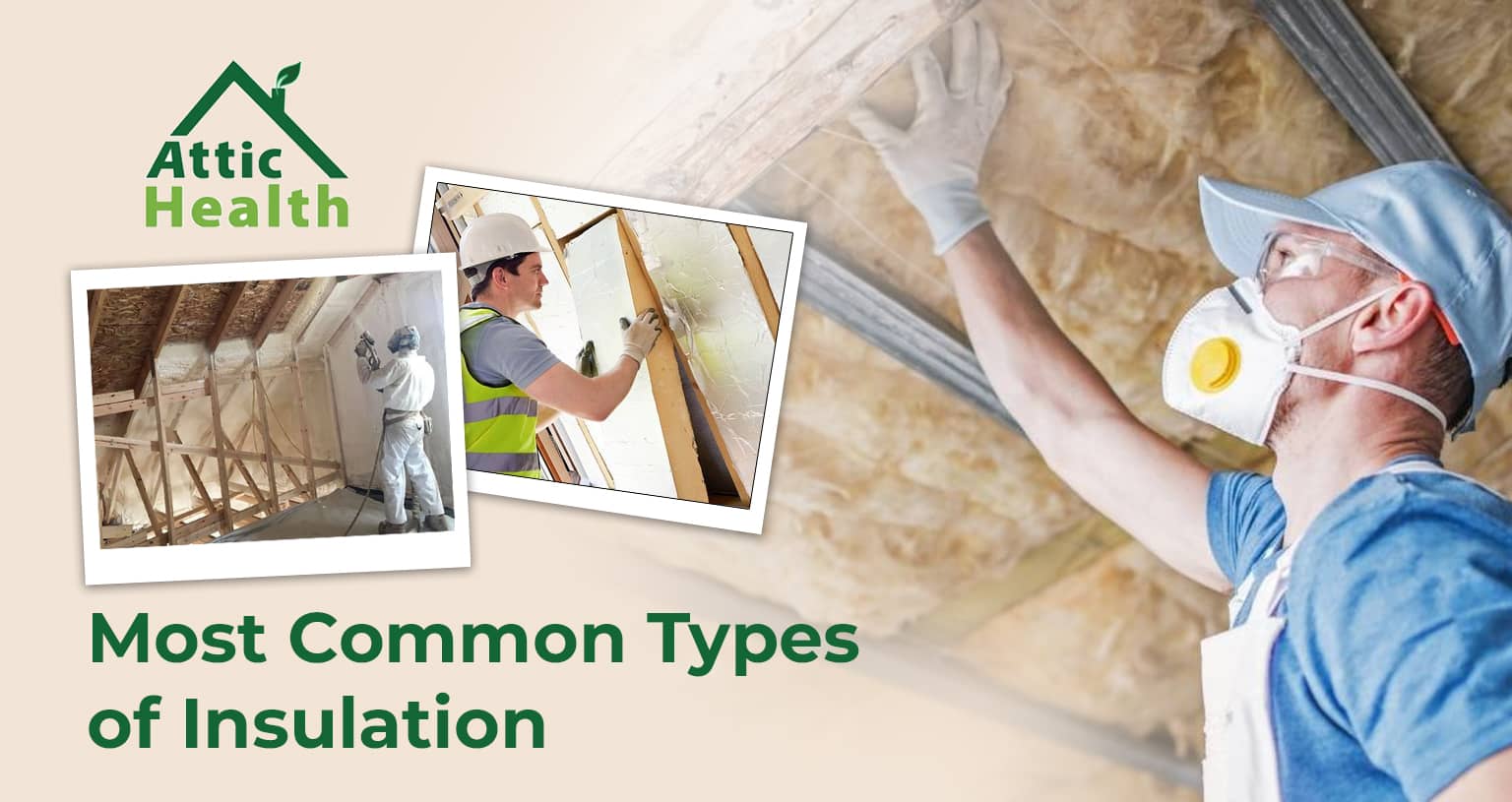There are quite a few types of insulation, so it is easy to get confused when shopping for a solution for your home’s attic. The insulation also needs to be removed from your attic and crawl space before you make the move to get new insulation, unless this is your first time. If this is your first install, you will also have air sealing, HVAC system, and other home efficiency projects on your mind. Insulation does not need to be so complicated, we suggest always that you just call us our for a Free inspection! We are happy to consult with our knowledge and experience to provide the best solution for your home.
Most Common Types of Insulation
Insulation is a material or technique used to reduce the transfer of heat, sound, or electricity between objects or spaces. For example, your attic keeping outside heat out so your HVAC system can be more efficient. There are several types of insulation, each with its own properties and best use cases.
- Fiberglass Insulation: Fiberglass attic insulation is made from fine glass fibers and is available in rolls or batts. It’s one of the most common types of insulation and is often used in walls, attics, crawl spaces, and ceilings. Fiberglass insulation is fire-resistant and can be an effective thermal and acoustic insulator. It’s relatively affordable but can be irritating to the skin and respiratory system during installation.
- Cellulose Insulation: Cellulose insulation is made from recycled paper products treated with fire-retardant chemicals. It’s blown into wall cavities, attics, and other spaces to create a dense layer of insulation. Cellulose is not recommended by our team as it is a poor investment in the long term.
- Mineral Wool Insulation: Mineral wool insulation, also known as rock wool or slag wool, is made from molten rock or industrial waste products spun into fibers. It’s available as batts or loose-fill and offers good fire resistance and sound absorption. Mineral wool is suitable for high-temperature applications and can be used in walls, ceilings, and attics.
- Spray Foam Insulation: Spray foam insulation is a liquid mixture that expands into a foam when applied to your attic’s interior. It forms an airtight and moisture-resistant barrier, providing excellent thermal insulation. There are two types of spray foam: open-cell (less dense, good for soundproofing) and closed-cell (denser, better thermal resistance). Spray foam is ideal for sealing gaps such as those found during the air leak discovery process, attics, basements, and crawl spaces. We do not recommend using large amounts of spray foam.
- Polyurethane Foam Insulation: Polyurethane foam insulation is another type of spray foam insulation that’s popular for its high insulating properties. It adheres well and provides an airtight seal. It’s commonly used in roofing and walls and is effective in reducing energy consumption.
- Polystyrene Insulation: Polystyrene insulation comes in two forms: expanded (EPS) and extruded (XPS). EPS is a lightweight, rigid foam often used in packaging and insulation. XPS is denser and has higher moisture resistance, making it suitable for below-grade applications and exterior insulation systems.
- Reflective Insulation: Reflective insulation consists of a reflective surface, often aluminum foil, applied to one or both sides of a material like cardboard, plastic, or polyethylene bubbles. It reflects radiant heat and is commonly used in attics, roofs, and walls, especially in hot climates.
- Radiant Barrier: Similar to reflective insulation, a radiant barrier reflects radiant heat. It’s often installed in attics to prevent heat transfer from the roof to the living spaces below. Learn more about the radiant barrier!
- Cotton Insulation: Made from recycled cotton fibers, this insulation type is eco-friendly and easy to handle. It provides good thermal and acoustic insulation and is typically used in walls, attics, and floors.
- Aerogel Insulation: Aerogel is an extremely lightweight and highly insulating material. It’s used in applications where space is limited, such as in space exploration or high-performance building insulation at NASA, so probably not found in your attic.
What types of insulation are best?
The best types of insulation to use depends on factors such as the specific application within your attic, desired thermal resistance (R-value), budget, local climate, conditions around the home, and any specific needs (e.g., fire resistance, moisture control, soundproofing). It’s important to consult with professionals and consider the unique requirements of your project before selecting an insulation type. You can also ask the professional to let a goal guide the project, for example requesting the most cost effective VS best insulation performance.
What types of insulation are best for an attic?
We try to make custom recommendations for each job as they all require different solutions and the homeowners all have different goals. For the best return on investment, our technicians will evaluate the current settings and discuss the value of savings produced by the insulations impact on your HVAC efficiency. For the best comfort in your home, Attic Health professionals will discuss the current settings of the thermostat and goals for the average temperature, and then make suggestions for achieving the homeowner’s comfort goals. The best insulation type is one that works to accommodate the homeowner’s goals for temperature control, has been installed by professionals, and is affordable considering the return on investment achieved through the savings brought on by HVAC efficiency versus the money spent on materials and installation expenses.
Attic Health Wrap-Up on Types of Insulation
There are myriad choices that can leave homeowners bewildered, clarity emerges from understanding the diverse range of options available. Having a goal in mind will help experts to guide you, but when comfort is in the balance, it is hard for someone else to make suggestions. Most humans do not consider the financial comfort of another person’s choice. With the attic being a focal point for all our insulation projects, the removal of pre-existing insulation surfaces as a crucial step, particularly for those venturing into insulation upgrades for the first time.
The landscape of considerations widens to encompass not just types of insulation, but also air sealing, HVAC systems, removal of old insulation, general post work clean-up and broader home efficiency. A guiding beacon we offer is our free inspection, where seasoned expertise will dive into solving all your attic worries and provide a report of their findings and suggestions.
From fiberglass to spray foam, cellulose to mineral wool, each insulation type stands as a testament to engineering’s versatility, shaped to tame heat, sound, and energy flow. Yet, paramount is the art of discernment, harmonizing the intricacies of thermal resistance, financial viability, climatic realities, and bespoke requisites. Our attic experts illuminate pathways that lead to the insulation that best nurtures comfort and curtails the cost goals. It is an expedition that binds aspiration with expertise, delivering insulation choices grounded in both practicality and foresight. Attic Health can be achieved!



